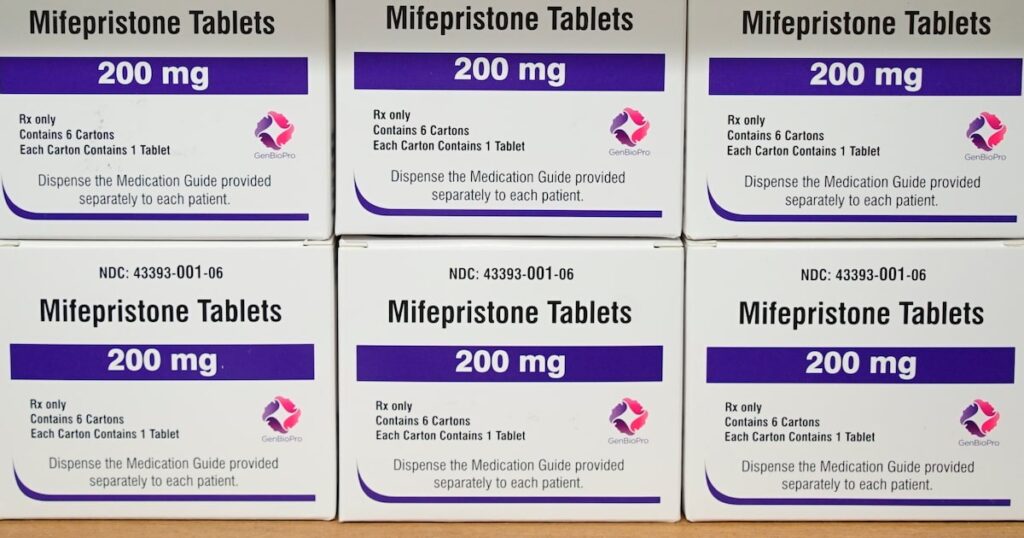Under a bill filed in the Legislature, Texas could begin monitoring wastewater for substances including the abortion drug mifepristone.
The legislation is part of a broader push spearheaded by anti-abortion advocates, including Students for Life of America, to classify mifepristone as an environmental pollutant.
Sen. Bryan Hughes, R-Mineola, the author of the Texas wastewater bill, said the proposed bill is about environmental monitoring rather than abortion.
“We want to know what’s in the water, wherever it’s coming from,” Hughes told the Dallas Morning News in a phone interview. “It’s hard to be against gathering information and finding out what chemicals are in the water.”
Abortion rights advocates framed the wastewater bill as an attack on abortion access during a legislative session with nearly one hundred abortion-related bills ― including a bill filed by Hughes that would ban the mailing of abortion medication into Texas.

“I think all of these are intimidation factors to paint abortion pills as dangerous, to make it so people feel like they can’t get these medications,” said Tamara Stein, deputy director of the abortions rights nonprofit Mayday Health.
Wastewater researcher Thomas Young, a professor of civil and environmental engineering at the University of California, Davis, said he doesn’t see a scientific reason to be specifically concerned about mifepristone in the water supply.
He and other researchers worry more about chemicals such as PFAS — the so-called “forever chemicals” — which pose a threat to animals and humans.
“I would say broadly that pharmaceuticals are not the thing that I’m most worried about,” Young said.
The bill
Senate Bill 1976 would require the state to test the water at some wastewater treatment facilities for the presence of nine named substances. Those include ethinyl estradiol — an ingredient in birth control pills — and mifepristone, the first pill prescribed for a medication abortion.
The bill went to a public hearing in mid-April and is pending in the Senate Committee on Water, Agriculture and Rural Affairs.
Hughes, who has championed anti-abortion legislation for years, described this bill as an environmental monitoring effort.
“It’s about water quality,” Hughes said.
He said he added mifepristone to the bill at the suggestion of groups he consulted for the bill, but did not specify which groups. His staff didn’t respond to follow up questions on the matter.
The anti-abortion group Students for Life provided Hughes’ office with model legislation, according to organization spokesperson Kristi Hamrick.
Hughes and his office pointed to federal hazard statements attached to mifepristone, which include that the drug can be harmful if swallowed or inhaled, and may cause damage to a fetus or a breast-fed child.

Young, the wastewater researcher, said mifepristone is a “perfectly fine thing to measure for in the environment” and that monitoring will likely turn up low levels in the water. But he wouldn’t have placed the drug on a short list of chemicals to monitor.
“I don’t think it would be scientifically in the top end of things that I would go after,” Young said. “But it hasn’t been measured that much, so maybe it’s more than I think.”
Opposing views
Students for Life of America has a mission of “abolishing abortion,” according to the organization’s website.
Environmental concerns are not the organization’s typical focus, but the group has spearheaded efforts at both the federal and state levels to increase water monitoring for abortion medication and fetal remains.
Between 2022 and 2024, one of the group’s sister organizations wrote five petitions to the FDA about mifepristone regulation, including environmental and water regulation. In 2024, the group wrote a letter to the United States Congress, asking for federal regulation of mifepristone’s impact on the environment.
This year, Students for Life of America has supported mifepristone monitoring bills in the Montana and Wyoming state legislatures.
The group also supports Hughes’ wastewater bill in Texas.
Hamrick, the vice president of media and policy at Students for Life of America and its political advocacy wing, said the organization’s concerns about environmental impact can stand separately from concerns about abortion generally.
“Even if you’re pro-abortion, that’s not an argument for dumping pathological medical waste into the drinking water. And if you’re arguing that there is no problem, then you won’t mind testing,” Hamrick said.
In part because the support for wastewater monitoring comes from anti-abortion voices, abortion rights advocates see the Texas move as a primarily anti-abortion bill.
“It is absolutely just about abortion restrictions. There is no real environmental concern behind these bills,” said Bella Pori, state legislative counsel at the Center for Reproductive Rights.
Pori worries bills such as the one in Texas could be used to further regulate mifepristone across the country.
Stein, at Mayday Health, said the bill sends the message that medication abortion is something to be feared.
“I think the messaging is, in and of itself, harmful because you hear these things are toxic and then people are scared to take them,” Stein said. “These are safe medications that are commonly used and are regulated.”
Young, the wastewater researcher, said he thinks people generally don’t understand how many substances are in the U.S. water supply, or that the presence of those substances is not necessarily harmful.
“There’s many pharmaceuticals — many of them equally potent to this one, anti-cancer drugs, chemotherapy drugs, things that are designed to be toxic so that they kill stuff — that are also being emitted in just the same way,” Young said.
“And I don’t think we’re going to stop people from getting cancer treatments.”


